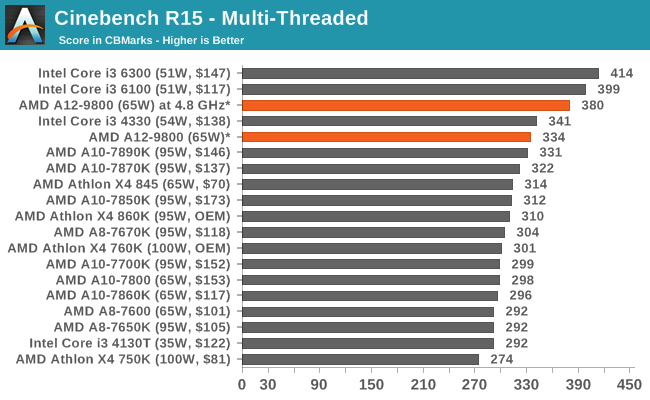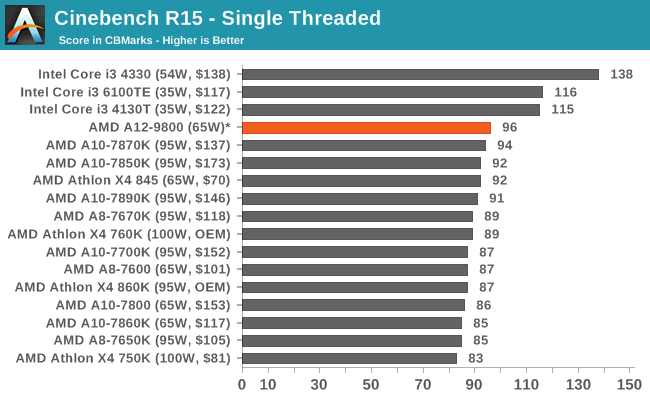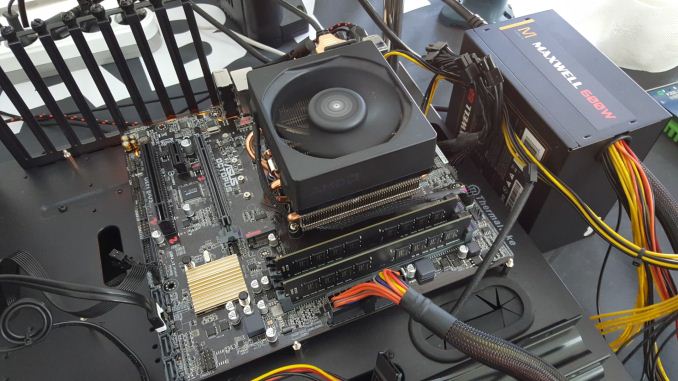AMD 7th Gen Bristol Ridge and AM4 Analysis: Up to A12-9800, B350/A320 Chipset, OEMs first, PIBs Later
by Ian Cutress on September 23, 2016 9:00 AM EST
Over the last two weeks, AMD officially launched their 7th Generation Bristol Ridge processors as well as the new AM4 socket and related chipsets. The launch was somewhat muted, as the target for the initial launch is purely to the big system OEMs and system integrators, such as Lenovo, HP, Dell and others – for users wanting to build their own systems, ‘Product-in-Box’ units (called PIBs) for self-build systems will come at the end of the year. We held off on the announcement because the launch and briefings left a number of questions unanswered as to the potential matrix of configurations, specifications of the hardware and how it all connects together. We got a number of answers, so let’s delve in.
The CPUs
The seven APUs and one CPU being launched for OEM systems spans from a high-frequency A12 part using the 7th Generation microarchitecture (we call it Excavator v2) to the A6, and they all build on the Bristol Ridge notebook parts that were launched earlier in the year but focused on the desktop this time around. AMD essentially skipped the 6th Gen, Carrizo, for desktop as the design was significantly mobile focused – we ended up with one CPU, the Athlon X4 845 (which we reviewed), with DDR3 support but no integrated graphics. Using the updated 28nm process from TSMC, AMD was able to tweak the microarchitecture and allow full on APUs for desktops using a similar design.
The full list of processors is as follows:
| AMD 7th Generation Bristol Ridge Processors | |||||
| Modules/ Threads |
CPU Base / Turbo (MHz) |
GPU | GPU Base / Turbo (MHz) |
TDP | |
| A12-9800 | 2M / 4T | 3800 / 4200 | Radeon R7 | 800 / 1108 | 65W |
| A12-9800E | 2M / 4T | 3100 / 3800 | Radeon R7 | 655 / 900 | 35W |
| A10-9700 | 2M / 4T | 3500 / 3800 | Radeon R7 | 720 / 1029 | 65W |
| A10-9700E | 2M / 4T | 3000 / 3500 | Radeon R7 | 600 / 847 | 35W |
| A8-9600 | 2M / 4T | 3100 / 3400 | Radeon R7 | 655 / 900 | 65W |
| A6-9500 | 1M / 2T | 3500 / 3800 | Radeon R5 | 720 / 1029 | 65W |
| A6-9500E | 1M / 2T | 3000 / 3400 | Radeon R5 | 576 / 800 | 35W |
| Athlon X4 950 | 2M / 4T | 3500 / 3800 | - | - | 65W |
AMD’s mainstream processors will now hit a maximum of 65W in their official thermal design power (TDP), with the launch offering a number of 65W and 35W parts. There is the potential to offer CPUs with a configurable TDP, however much like the older parts that supported 65W/45W modes, it was seldom used, and chances are we will see OEMs stick with the default design power windows here. Also, the naming scheme: any 35W part now has an ‘E’ at the end of the processor name, allowing for easier identification.
As part of this review, we were able to snag a few extra configuration specifications for each of the processors, including the number of streaming processors in each, base GPU frequencies, base Northbridge frequencies (more on the NB later), and confirmation that all the APUs launched will support DDR4-2400 at JEDEC sub-timings.
| AMD 7th Generation 65W Bristol Ridge Processors | |||||
| Modules/ Threads |
CPU Base / Turbo (MHz) |
GPU SPs |
GPU Base / Turbo (MHz) |
Northbridge Base (MHz) |
|
| A12-9800 | 2M / 4T | 3800 / 4200 | 512 | 800 / 1108 | 1400 |
| A10-9700 | 2M / 4T | 3500 / 3800 | 384 | 720 / 1029 | 1400 |
| A8-9600 | 2M / 4T | 3100 / 3400 | 384 | 655 / 900 | 1300 |
| A6-9500 | 1M / 2T | 3500 / 3800 | 384 | 720 / 1029 | 1400 |
| Athlon X4 950 | 2M / 4T | 3500 / 3800 | - | - | 1400 |
| AMD 7th Generation 35W Bristol Ridge Processors | |||||
| Modules/ Threads |
CPU Base / Turbo (MHz) |
GPU SPs |
GPU Base / Turbo (MHz) |
Northbridge Base (MHz) |
|
| A12-9800E | 2M / 4T | 3100 / 3800 | 512 | 655 / 900 | 1300 |
| A10-9700E | 2M / 4T | 3000 / 3500 | 384 | 600 / 847 | 1300 |
| A6-9500E | 1M / 2T | 3000 / 3400 | 256 | 576 / 800 | 1300 |
The A12-9800 at the top of the stack is an interesting part on paper. If we do a direct comparison with the previous high-end AMD APUs, the A10-7890K, A10-7870K and A10-7860K, a lot of positives end up on the side of the A12.
| High-End AMD APU Comparison | |||||||
| A12-9800 | A10-7890K | A10-7870K | A10-7860K | A10-9700 | |||
| MSRP | - | $165 | $137 | $117 | - | ||
| Platform | Bristol Ridge | Kaveri Refresh | Bristol Ridge | ||||
| uArch | Excavator v2 | Steamroller | Steamroller | Steamroller | Excavator v2 | ||
| Threads | 2M / 4T | 2M / 4T | 2M / 4T | 2M / 4T | 2M / 4T | ||
| CPU Base Freq | 3800 | 4100 | 3900 | 3600 | 3500 | ||
| CPU Turbo Freq | 4200 | 4300 | 4100 | 4000 | 3800 | ||
| IGP SPs | 512 | 512 | 512 | 512 | 384 | ||
| GPU Turbo Freq | 1108 | 866 | 866 | 757 | 1029 | ||
| TDP | 65W | 95W | 95W | 65W | 65W | ||
| L1-I Cache | 192 KB | 192 KB | 192 KB | 192 KB | 192 KB | ||
| L1-D Cache | 128 KB | 64 KB | 64 KB | 64 KB | 128 KB | ||
| L2 Cache | 2 MB | 4 MB | 4 MB | 4 MB | 2 MB | ||
| DDR Support | DDR4-2400 | DDR3-2133 | DDR3-2133 | DDR3-2133 | DDR4-2400 | ||
| PCIe 3.0 | x8 | x16 | x16 | x16 | x8 | ||
| Chipsets | B350 A320 X/B/A300 |
A88X A78 A68H |
A88X A78 A68H |
A88X A78 A68H |
B350 A320 X/B/A300 |
||
The frequency of the A12-9800 gives it a greater dynamic range than the A10-7870K (having 3.8-4.2 GHz, rather than 3.9-4.1), but with the newer Excavator v2 microarchitecture, improved L1 cache, AVX 2.0 support and a much higher integrated graphics frequency (1108 MHz vs. 866 MHz) while also coming in at 30W less TDP. The 30W TDP jump is the most surprising – we’re essentially getting better than the previous A10-class performance at a lower power, which is most likely why they started naming the best APU in the stack an ‘A12’. Basically, the A12-9800 APU will be an extremely interesting one to review given the smaller L2 cache but faster graphics and DDR4 memory.
A Wild Overclocker Appears!
Given that technically the systems with the new APUs have been released for a couple of weeks, some vendors have their internal enthusiasts play around with the platform. Bearing in mind that AMD has not announced any formal overclocking support on these new APUs, NAMEGT, a South Korean overclocker with ties to ASUS, has pushed the A12-9800 APU to 4.8 GHz by adjusting the multiplier. To do this, he used an unreleased ASUS Octopus AM4 motherboard and AMD’s 125W Wraith air cooler (which will presumably be bundled with PIBs later in the product cycle).
NAMEGT ran this setup on multithreaded Cinebench 11.5 and Cinebench 15, scoring 4.77 and 380 respectively for a 4.8 GHz overclock. If we compare this to our Bench database results, we see the following

For Cinebench 15, this overclocked score puts the A12-9800 above the Haswell Core i3-4360 and the older AMD FX-4350, but below the newer Skylake i3-6100TE. The Athlon X4 845 at stock frequencies scored 314 while running at 3.5 GHz, which would suggest that a stock A12-9800 at 3.8 GHz would fall around the 340 mark.

(Since writing this, a preview by Korean website Bodnara, using the A12-9800 in a GIGABYTE motherboard, scored 334 for a stock Cinebench 15 multithreaded test and 96 for the single threaded test. We've added this result for perspective.)

When we previously tested the Excavator architecture for desktop on the 65W Athlon X4 845, overclocking was a nightmare, with stability being a large issue. At the time, we suspected that due to the core design being focused towards 15W, moving beyond 65W was perhaps a bit of a stretch for the design at hand. This time around, as we reported before, Bristol Ridge is using an updated 28nm process over Carrizo, which may have a hand in this.
When we asked AMD about overclocking details on the new APUs, the return reply was along the lines of ‘No OEM systems at this time will be unlocked, and no official comment on the individual units. More details will be released closer to the platform launch for DIY users’.












122 Comments
View All Comments
Haawser - Thursday, September 29, 2016 - link
Actual evidence points to GF.Look at the photo of the chip- http://wccftech.com/amd-bristol-ridge-a12-9800-am4...
'Diffused in Germany' means the chip itself was made at GF in Dresden. Then shipped to Malaysia for packaging. Unless the photo is fake. Which is unlikely.
DOS5 - Tuesday, October 4, 2016 - link
Wondering if I understood correctly -- is video card slot limited to 8 lanes? If so, how will this affect APU with video card as primary, APU with video card in dual graphics, and Athlon x4 CPU with video card?Marstg - Saturday, October 22, 2016 - link
Mr Cutress, we are one month later, where is the Bristol Ridge hardware? It would seem easier to reach out to Costco than AMD and have the platform tested. Where are you guys with that?Camdex - Tuesday, February 7, 2017 - link
Interesting article but disappointed in the overclocked benchmarks. AMD can say what they want about Excavator v2 cores but if these benches at 4.8ghz are legit its only going to slightly put it over the recent Athlon 860k. Im doing this comparison based on the future Athlon will be based off the A12 9800. My Athlon 860k gets a cinebench r15 score of 368 at 4.5ghz. IF it overclocked to 4.8ghz I'd bet it'd score right around the same 380 the A12 9800 did. On the plus side IF 4.8ghz is possible on the new Excavator v2 based chips and the power consumptuon is down thats a big plus. I was just hoping the new Athlons would be scoring a bit better say near 400 in cinebench r15 at stock clocks and for $100 or less. But hear this INTEL... I will never pay $180 for a dual core even if it does overclcock well. The new i3 7350k is a joke.Gadgety - Sunday, February 26, 2017 - link
AMD did something similar with the A8-7600 midrange APU. Announced it, launched it, allowed testing by tech sites, and gave OEMs full access, but it took a full 8 months before it was available to the general public.msroadkill612 - Wednesday, April 26, 2017 - link
testGlock24 - Sunday, May 14, 2017 - link
We already have Zen and Bristol Ridge is nowhere to be found anywhere apart from OEM systems. What a shame, would've made a decent office computer.Shayne03 - Saturday, December 2, 2017 - link
Hi i bought a10-9700 with stock hs and a320m vh plus msi motherboard.. my cpu temperature is always at 50 to 60 degree is it normal?